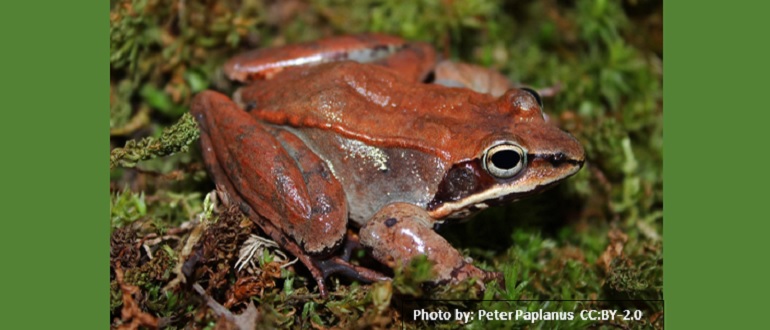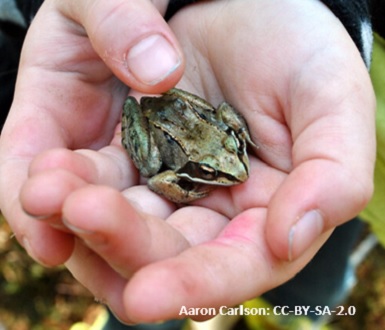GET TO KNOW: Wood frogs
If the early bird gets the worm, what does the early frog get? Perhaps a bug as well, but in the case of some tiny, spring frogs – the early frog gets to sing a love song.
FUN FACT – Wood frogs have the largest range of all North American frogs and are the only North American frog found north of Arctic Circle. There, in the coldest reaches of its range, the wood frog spends more of each year in its frozen state of hibernation than it does awake and hopping around.
It seems that a few of our smallest watershed residents, a trio of early spring frogs, have found an evolutionary advantage in waking up early from winter hibernation. In the very first days of spring, these tiny frogs crawl from under logs and leaf litter to find their mate. In so doing, they successfully breed a new generation weeks before neighboring predators (primarily snakes and larger frogs) wake from their own winter slumber.
The wood frog is the largest (2” – 3” in length) of this trio of spring frogs. Yet it is possibly the most difficult to spot. For, while early spring chorus frogs and “peepers” raise joint voices in resounding evening choirs, male wood frogs emit solitary, raspy, little sounds. The calls might be mistaken for ducks quacking and have been likened to the clucks of chickens or turkeys. Hear them for yourself. Additionally, wood frogs are likely to be out and about in the pond for only a few short days. Known for patterns of “explosive breeding,” they hurry through their mating ritual in a short, intensive burst of activity and then retreat to the relative safety and camouflage of the woodland.
When spotted, wood frogs are best recognized by the black “bandit mask” across their eyes and accompanying white stripe along their upper lip. Otherwise, these little frogs display a wide variety of color morphs across their back and may appear in shades of brown, green, or gray that vary with local populations.
HABITAT AND LIFECYCLE
The lifecycle of wood frogs (Rana sylvatica) is equally dependent on two separate environments: the spring vernal pond and moist woodlands.
One critically important aspect of a vernal – or temporary – spring pond is that it does not connect to any other waterways and does not contain fish.
Note: the wood frog is often labeled as Lithobates sylvaticus in older writings.
Female wood frogs lay their eggs in such sheltered, fish-free ponds in order to reduce predation of eggs and tadpoles. Interestingly, females often lay their eggs in communal masses of as many as 1,000 eggs, and it is believed that tadpoles recognize and swim with their own siblings for sixty plus days until they mature into frogs. However, the very fleeting nature of a vernal pond presents its own danger. For if there is too little spring rain, the pond, with its resident tadpoles, may dry up prematurely.
As both tadpoles and adults, wood frogs have permeable skin that requires moisture from the environment. Consequently, these creatures are adversely affected by poor water quality and absorb dissolved toxins within the water. Therefore, their presence in a watershed is celebrated as an indicator of good water quality.
Once tadpoles reach adult frog stage, they leave the pond and spend their days foraging on the forest floor for spiders and insects. These small frogs take shelter under logs and leaf litter and within the foliage of ground level plants. Camouflage is their best defense from snakes and the occasional passing skunk. However, they can emit a mildly toxic glandular secretion that might deter a small predator from eating them.
Wood frogs are one of several cold-blooded species that survives freezing winter temperatures by freezing themselves. They simply crawl into a shallow “hidey-hole” – called a hibernaculum – and enter a deep, and frozen state of hibernation. Their bodies generate high levels of urea and glucose compounds (that are stored in the liver) that serve as a type of “intra-cellular antifreeze.” This keeps individual cells alive while the fluids between cells freeze. Of course, once daytime temperatures begin to climb in spring, the tough, little wood frog thaws itself out and wakes up. And, since the average lifespan of a wood frog is around three years, a lucky little wood frog might experience this freeze and thaw cycle three times.
TAKE ACTION
You can easily learn to identify wood frog and other frog and toad calls using the “Froggy voice” app that was developed by one of FOTR’s volunteers. Wood frogs are one of the first species to call in the spring but can easily missed because of their short breeding season. Become a frog and toad survey volunteer and monitor your area for calling frogs and toads. There are also things you can do around your property to improve habitat for frogs and toads.
It is an unfortunate fact that toxins, such as motor oils, road salt, soaps, fertilizers, and pesticides wash into our waterways with stormwater run-off. The EPA estimates that such run-off (labeled “non-point source” pollution) now accounts for as much as 80% of pollutants entering our waterways. Wetlands are critical habitat for amphibians like wood frogs and can absorb and filter pollutants before they move downstream and need to be preserved.
Green infrastructure programs, such as rain gardens, permeable paving and green roofs can help reduce and filter stormwater run-off and protect our watershed. However, the most important reductions in toxins can only come from reducing the overall consumption of such items – such as road salt.
Categories
-
News & EventsLearn more about upcoming FOTR events and projects

